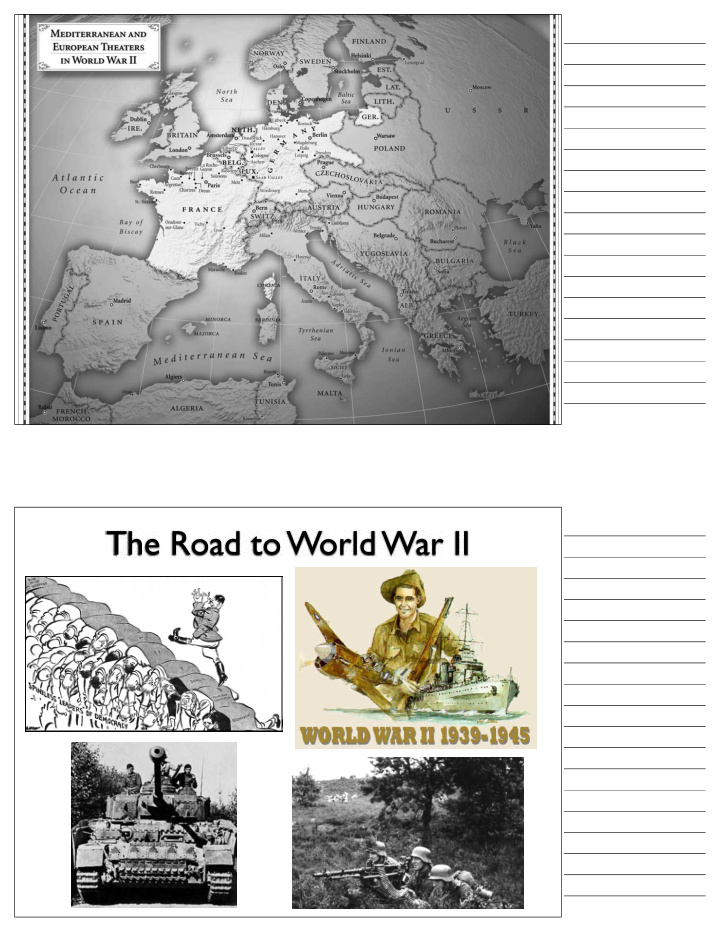



The Road to World War II
The Weimar Republic name of the post-WWI government in Germany millions of Germans blamed the Weimar government for their country’s defeat and postwar humiliation Inflation Causes Crisis in Germany Germany had not greatly increased its wartime taxes to pay for the war; they had simply printed more money (marks). Heavy reparations payments caused the value of the mark to fall sharply, causing severe inflation. Germans needed more and more money to buy the most basic goods. In Berlin a loaf of bread cost less than a mark in 1918, more than 160 marks in 1922, and some 200 billion marks by late 1923.
The Dawes Plan created in 1923 by an international committee headed by Charles Dawes, an American banker the Dawes Plan Put into effect in provided a loan from 1924, the Dawes Plan American banks to helped slow inflation. stabilize German currency and As the German strengthen its economy began to economy recover, it attracted the plan also more loans and restructured investments from the Germany’s reparations United States. payments The Kellogg-Briand Pact in 1928, Frank Kellogg, US Secretary of State, arranged an agreement pledged “to renounce war as an instrument of national policy” almost every country in the world signed the treaty the treaty had no means to enforce its provisions
1929 American Financial Collapse: Underconsumption the richest 5% of the population earned 33% of all personal income 60% of all American families earned <$2,000/year few could buy the goods being produced store owners cut back their orders from factories factories reduced production and laid off workers workers lost their jobs and then bought even fewer goods factories made further cuts in production and laid off more workers 1929 American Financial Collapse: Overproduction scientific farming and new machinery dramatically increased farmers’ crop yields a worldwide surplus of agricultural products drove prices and profits down many farmers could not pay off the bank loans that kept them in business these unpaid debts weakened banks and forced some to close
1929 American Financial Collapse: Speculation in September 1929, some investors many middle- started selling their income people stocks began buying panic ensued; stocks on margin prices plunged to a new low on “Black Tuesday,” October 29, 1929, the Stock Market collapsed A Global Depression Worried American bankers demanded repayment of their overseas loans, and American investors withdrew their money from Europe. The US Congress placed high tariffs on imported goods so that American dollars would stay in the United States and pay for American goods. Other nations imposed their own higher tariffs. World trade dropped by 65 percent. Unemployment rates soared.
The Failures of Versailles • Germany’s economy was in a shambles • The Versailles Treaty failed to provide a “just and secure peace” as promised • Instead Germany grew more and more resentful of a treaty they felt was too harsh and too punitive The Versailles Treaty (above on crutches) took a beating in the U.S. and abroad Adolf Hitler • WWI veteran • joined a struggling political group called the National Socialist German Workers’ Party • Hitler’s skill in public speaking and ability to organize support allowed him to quickly become a leader in the Nazi Party • In his book, Mein Kampf he explained that he wanted to unite all German-speaking people • He wanted racial purity – “inferior” races were to form a work force for the “master race” – “Aryans” Hitler in WWI, far left
Hitler Gains Power • By mid-1932, the Nazis had become Germany’s strongest political party • In January of 1933, Hitler was appointed Chancellor • He quickly dismantled Germany’s democratic government and replaced it with a totalitarian government • Called himself “Der Fuhrer” and his rule of Germany the “Third Reich” • He promised to return Germany to its former glory Germany Rearms Hitler visits a factory and is enthusiastically greeted. Many Germans were grateful for jobs after the misery of he depression years.
Germany Remilitarizes the Rhineland March 1936 The Rhineland was the region of Germany that was ‘demilitarized’ after the Treaty of Versailles. Nazi Germany Expands: Austria Another element of Hitler’s grand design was creating “Lebensraum” In March, 1938, German troops marched into Austria unopposed. The arrival of German troops was met with great enthusiasm by the Austrians. The majority of Austrians favored unification with Germany A day later, Germany announced its union with Austria, which it called “Anschluss”
Nazi Germany Expands: the Sudetenland Many German-speaking people lived in the western border regions of Czechoslovakia called the Sudetenland In 1938 Hitler occupied the Sudetenland An occupation of the rest of Czechoslovakia seemed imminent. The Munich Conference September 1938 The leaders of Germany (Adolf Hitler), Italy (Benito Mussolini), France (Edouard Daladier), and Great Britain (Neville Chamberlain) met in Munich, Germany. Chamberlain and Daladier believed Hitler promised the Hitler and signed the annexation of the Munich Agreement Sudetenland would be that turned over the has “last territorial Sudetenland to demand” Germany without repercussions. Chamberlain returned to England and announced, “I have come back from Germany with peace with honor. I believe it is peace in our time.” Critics called this a dangerous policy of appeasement – or giving up principles to pacify an aggressor.
Nazi Expansion Continues On March 15, 1939 German troops invaded and occupied the rest of Czechoslovakia. In August of 1939 Germany and the USSR signed a non-aggression pact. This paved the way for Germany to take Poland without fear of an attack from the USSR. On September 3rd, 1939, Germany invaded Poland. The Soviets received part of Poland (a promise made in the non-aggression deal between Germany and the USSR). Great Britain and France, allies of Poland, declared war on Germany. World War II had officially begun.
Recommend
More recommend